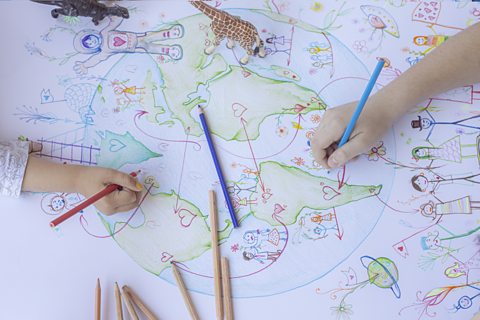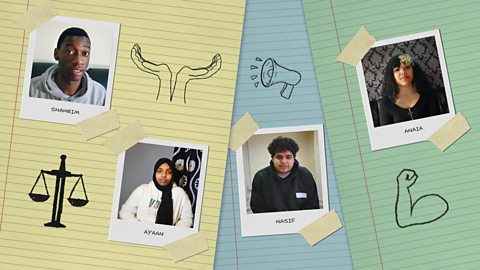When I went back to school after lockdown, people said more offensive things about Asians.
From online abuse directed at football player Son Heung-Min, to widespread reports of the increase in anti-Asian hate crime, the impact of Covid-19 on people of East and South East Asian heritage has been widely reported.
In April, C¬ť∂Ļ‘ľŇń Newsround met with some young people of Chinese heritage to find out about their experiences over the course of the year, with some children reflecting that they felt fearful, even in a school environment.
For Dr Jon Tan, a Senior Lecturer in Education at the Centre of Race Education and Decoloniality, this isn‚Äôt something new. ‚ÄúThere is longstanding documentation of violence and discrimination that is also very traditionally underreported amongst this community.‚ÄĚ
A report in 2009 found that , but that due to data collection practices and the responses of public agencies, these experiences are largely not in the public eye.
‚ÄúChildren of school age aren‚Äôt insulated from these experiences,‚ÄĚ Jon adds. The same report found that a majority of perpetrators of racist crimes against Chinese victims were children and young people, and in March this year, the Guardian‚Äôs freedom of information requests sent to 201 councils and about a fifth of England‚Äôs multi-academy trusts revealed .
A survey run by YouGov in June 2020 found that out of a sample size of 1,270 adults of diverse ethnic heritage in the UK, , and in an in-depth study of the experiences of racism amongst East and South East Asian people in the UK, conducted in March 2021, .
So how can teachers help support their students of East and South East Asian descent who might have experienced incidents of racism?


Consider incidents as learning opportunities
‚ÄúIt‚Äôs important that schools consider these incidents as learning opportunities,‚ÄĚ Jon says. ‚ÄúFor teachers for continuing professional development, for schools as learning organisations and for young people in terms of sharing cultural knowledge.‚ÄĚ
‚ÄúI‚Äôm particularly concerned about how the issues around Covid-19 have been represented in the media, about the eating of certain animals. There is a job for schools to do about the understanding of these issues ‚Äď opportunities to have discussions around different cultures and how the transfer of diseases from animals to humans work, to reset the balance in terms of how these conversations around viruses and transmission are represented.‚ÄĚ
Craig Perkinton is a mixed-race white and Malaysian teacher who taught at primary in the UK and is now based at an international school in China. He says: "Teachers need to be honest with themselves about their own ignorance of a pupil’s culture and seek education to rectify it, and we should allow time for open and fair discussion as part of P4C (Philosophy for Children) and circle times."
Having been both a student and a teacher in the UK, he is mindful of his experience and how assumptions and stereotypes can be problematic, even when they appear to be positive. "I've had things like: 'You must be good at maths.' and 'Of course you're good at the piano - you're Asian.'" He attributes that in part to lack of knowledge amongst his peers growing up, but it raises a key point about not assuming culture based on a person's heritage.
Doing your own research is key, and pressure shouldn't be put on the students to do the educating, Craig asserts. Teachers shouldn't "use the Chinese children in school to help support learning about Chinese culture".
And the same could be said for teachers. ‚ÄúWhen you perhaps have teachers from that community within that school environment, we have to be careful about their responsibility as a role model,‚ÄĚ Jon says. ‚ÄúThere is a sense that because the community is so underrepresented in teaching, that there is a weight of responsibility and expectation that is often put upon that individual to equip the rest of the teaching staff with knowledge. We do have to put in place support for those people.‚ÄĚ
‚ÄúSchools shouldn‚Äôt turn to their teachers of colour to be race experts,‚ÄĚ Professor Vini Lander, the Director of the Centre for Race, Education and Decoloniality, adds. ‚ÄúWhite teachers should be allies, but they should also have courage and lead the way. It‚Äôs not enough to say you‚Äôre not racist. You have to be actively anti-racist.‚ÄĚ
Craig has similar thoughts. "We need to stop the idea that people from outside of a particular culture cannot interact because they feel embarrassed, worried or guilty. By creating the right relationship with your pupils, you open up channels of communication with the pupils and their families."

Be ready
And whilst it's important to learn from these incidents, the educators we spoke to also highlighted the significance of a whole-school anti-racist culture in supporting children of all backgrounds.
‚ÄúTeachers need to have an ongoing discussion about racism, look at the socio-political climate, and almost pre-empt the incidents,‚ÄĚ says Vini. ‚ÄúThere are now lots of discussions around the Indian Covid-19 variant. Is there something that teachers can almost pre-empt? Know that racism is going to be a possibility. Do you know your school‚Äôs anti-racism policies?‚ÄĚ
The World Health Organisation has recently announced a new naming system for variants of Covid-19 to simplify discussions but also to help remove some stigma from the names.
‚ÄúAll staff need to be prepared to act and be confident in the actions that they take,‚ÄĚ Vini adds. ‚ÄúNot just teachers, but the whole school ‚Äď dinner supervisors, site managers, TAs, other people in the school community as well ‚Äď the shopkeeper, the governors. Is there a governor whose remit includes looking after the welfare of minority ethnic groups? Is the school sensitive to how the children are feeling, for example, about George‚Äôs Floyd‚Äôs death last year?‚ÄĚ
‚ÄúDoes the curriculum address issues of race and racism? Reflect this in the pedagogy and the whole curriculum ‚Äď so you‚Äôre sending out messages to everyone who walks through the doors of your school.‚ÄĚ
And it's not just about combating racism, but more widely about inclusion and celebrating diverse experiences and perspectives. "In my personal opinion, we don't teach empathy in schools," Craig says. "There needs to be more emphasis on teaching empathy as a skill that needs to be practised through role play and discussion."
He also thinks that more multi-cultural teaching needs to be done. "It can't be an additional extra, like the Shang Dynasty as an optional history focus," but really including more diverse perspectives and examples in topic work, or significant inspirational figures from different backgrounds in the study of history, science and literature.
Communicate that racism isn't tolerated
‚ÄúNever allow an incident of racism to go unchallenged,‚ÄĚ says Vini. ‚ÄúThis builds trust amongst all children, staff and parents of minority ethnicities. You need to have a zero tolerance approach.‚ÄĚ
She‚Äôs worked with some young people over the years who have lost trust in these support systems. She shares some of the things young people have said to her. "Some teachers tell us to ignore it. Some teachers tell us: ‚ÄėYou‚Äôre better than that.‚Äô Some teachers say: ‚ÄėIt‚Äôs just name calling‚Äô. Tell them not to give us another assembly on it."
Craig recommends being mindful of the child's position and the danger of singling them out. "As a student," he recalls, "I didn’t want any extra attention. We should have more general open discussion as part of the curriculum, rather than specially created events."
A , created by respect me, Scotland's anti-bullying service, and the Coalition for Racial Equality and Rights (CRER), provides guidance on the use of language. "Racist language can be used without malice or understanding, but this does not mean that it has no impact on young people who hear it used in this way."
‚ÄúRacism causes trauma and hurt," Vini stresses. "It doesn‚Äôt matter if you‚Äôre five, 35 or 85 ‚Äď you don‚Äôt get used to it. It‚Äôs an issue of health and safety, and of the wellbeing of that child. Is your school a safe space for that child? See it in the round. See it as an issue of wellbeing, not just of the child, but of your institution.‚ÄĚ
And it’s not the responsibility of a single teacher to address this. "One thing with issues about racism generally is that teachers, when they experience an incident of racism, can feel very isolated and ill-equipped to have the conversation," Jon says. "It's important for schools to approach these things as a collective resource, a collective response, instead of it being put upon a particular member of staff."
‚ÄúSome schools haven‚Äôt got a mechanism for documenting these incidents, and there is a reluctance to document these incidents when you haven‚Äôt got a pathway to addressing these issues, but schools have an accountability to their students to try and help.‚ÄĚ
At present, there is no legal requirement on schools to report racist incidents to their local authorities, but some schools and local authorities might have individual arrangements in place.
Work with parents and families
‚ÄúBe alert to whether it‚Äôs always the same children,‚ÄĚ Vini advises. ‚ÄúIs there work to be done with families via parental engagement?‚ÄĚ
‚ÄúIf you‚Äôre going to change the environment, there should be an element of restorative action, both with the victim and the perpetrator, and potentially with their families. Listen to the pupils and parents.‚ÄĚ
‚ÄúExpect some pushback from parents, as the child might be repeating views that they might have heard outside school. A common thing you hear from parents is: ‚ÄėThey didn‚Äôt hear it at home.‚Äô‚ÄĚ
‚ÄúIt‚Äôs actually quite uncommon for East Asian and South East Asian communities, who are traditionally quite private in their dealing with racism, to have these conversations,‚ÄĚ says Jon. ‚ÄúSchools in working with these communities have to develop this sense of trust and openness and that there will be a pathway for dealing with these issues. Be open that the school as an institution is undergoing a learning journey that could be helped by these communities and that perhaps they can build a more trusting relationship.‚ÄĚ

Recognise that this is a process
It‚Äôs important to acknowledge that this isn‚Äôt an issue that can be solved overnight. Vini thinks it‚Äôs all about developing racial literacy and confidence as well as having the knowledge and understanding of how racism operates. ‚ÄúI‚Äôve been in education for 30 years and I‚Äôve seen cycles of people‚Äôs racial awareness. There is a feeling that the problem has been fixed and then that awareness goes away. Tackling racism and developing race equality is always a work in progress. We have to always keep trying because racism changes and is denied.‚ÄĚ
Jon agrees. ‚ÄúIt‚Äôs about trying to find ways in which these conversations can become part of a supporting fabric of a school‚Äôs professional community. They‚Äôre ongoing conversations, not responses to something that is an isolated particular incident. These are issues that require long-term strategic investment in terms of professional time. There is a level of teachers wanting to know: ‚ÄėWhat do I do now?‚Äô, but to some extent, these discussions have to be built as an ongoing conversation.‚ÄĚ
But there is hope. In the wake of George Floyd‚Äôs death, Vini set up an anti-racist school award, with 70 schools signing up. She is heartened by the fact that schools have signed onto the award with real commitment. ‚ÄúThere is a good take up of the CPD that I‚Äôve delivered to schools. Talking to teachers and head teachers, they see the problem on the ground and they want to address it.‚ÄĚ
And Jon sees this as an opportunity to tackle some wider issues in the perception of East and South East Asian communities in society. ‚ÄúIt feels, from a person who comes from a Chinese mixed heritage background, you see a very cynical representation of Chinese communities in all sorts of ways, and that‚Äôs historical. There‚Äôs a bigger conversation that needs to happen about the representation particularly of Chinese communities. Perhaps this is an opportunity now to address some of these longstanding, unconscious and sometimes very conscious biases.‚ÄĚ


Being an ally to your students from black, South Asian and mixed heritage backgrounds. collection
In these short films students and teachers share their tips for encouraging everyone to be better allies and for working towards a truly inclusive educational experience.

How to promote an inclusive environment in your school. document
Diversity and inclusion education consultant Aisha Thomas gives tips and advice about implementing diversity and inclusion strategies in your school.

The Colour of my Skin - Celine's Story. video
In this short animated film Celine (not her real name) speaks openly about how the hostility she experienced from her local community made her feel unsafe, and how she reached out to her school for support.
